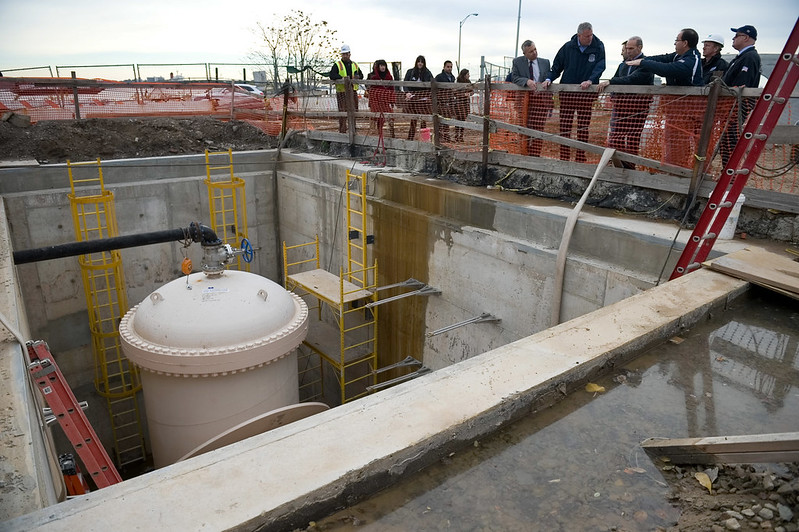
Existing infrastructure needs major investment (photo: Ed Reed/Mayoral Photography Office)
Governor Cuomo traveled to Washington on Wednesday to meet with President Trump, where he pitched the president on infrastructure investments like an expanded Second Avenue Subway and a new Penn Station. The governor is right to push for a national public works program, which would get thousands of newly unemployed Americans working again while tackling urgent infrastructure needs.
The last time the nation embarked on a major public works program, it produced dozens of large-scale projects in New York that helped dig the city and the country out of the Great Depression—from the RFK Bridge, the Lincoln Tunnel, and LaGuardia Airport to post offices, hospitals, high schools, and swimming pools across every borough.
A bold public works program would give New York a similar boost during these devastating economic times. But New York’s infrastructure needs are different than they were during the 1930s. Today, what the city needs most is a massive campaign to upgrade and maintain the infrastructure it already has.
For decades, New York City has fallen behind the mounting state-of-good-repair needs of its crumbling public infrastructure, with serious consequences for the city’s livability and long-term health.
For instance, while building new miles of subway is a worthy goal, the urgent need is to stabilize the current system. Fixing the city’s crumbling subways and modernizing the bus system will require at least $40 billion over the next five years, including $7 billion just to upgrade decades-old signals and cut down on delays. These investments can restore confidence in public transit in a moment of crisis—and with the system shut at night and the city on lockdown, now is the time to get to work.
New York City’s aging infrastructure needs extend far beyond public transit. The city’s beleaguered public housing—home to a disproportionate share of residents impacted by the current crisis—is waiting on more than $31 billion in urgent infrastructure repairs, including crucial fixes to moldering apartments and crumbling facades.
The city’s average public hospital—essential to the pandemic response—is over 57 years old, and the system is staring down nearly $400 million in critical repair and maintenance costs.
The city’s public parks—especially vital now that New Yorkers have few other options for recreation and exercise—are more than 73 years old, on average, and face more than $634 million in needs, including decaying drainage systems, crumbling retaining walls, and disintegrating bulkheads.
Parks are far from the city’s only green infrastructure challenges. Thousands of acres of concrete and asphalt need to be greened to reduce stormwater runoff. And meeting the city’s ambitious targets for reducing greenhouse gas emissions will require fast-tracked upgrades to retrofit far more public buildings.
Many of these assets receive little notice until they fail. Over the past decade, the city has averaged 459 water main breaks annually, more than one per day. The number of fracture-critical bridges jumped from 47 in 2012 to at least 67 in 2018.
Add to the list the stunning repair needs affecting the city’s public schools, colleges, and libraries—institutions that provide a sense of community in neighborhoods citywide, while preparing New Yorkers to participate in the economic recovery.
The Department of Education has nearly $2.5 billion in urgent, short-term capital needs, with over $100 million more at CUNY’s community colleges. And the city’s three public library systems—where the average branch library is more than 65 years old—are facing nearly $900 million in capital expenses to overhaul aging branches, replace leaky roofs, fix broken boilers, and upgrade HVAC systems. In addition, these institutions and many others need major upgrades to expand broadband access and help close the city’s persistent digital divide.
As the city at the epicenter of a national catastrophe, New York will need a historic level of federal investment to restore livelihoods and restart the country’s largest local economy, with lasting benefits for the nation and the world. Investing in infrastructure is a vital place to start.
But in a city as old as New York, the first priority should be repairing, restoring, and modernizing the aging infrastructure that we’ve already got. There’s no shortage of shovel-ready work to do.
***
Jonathan Bowles is executive director of the Center for an Urban Future, a New York–based think tank focused on expanding economic opportunity. Eli Dvorkin is CUF’s editorial and policy director. On Twitter @jbowlesnyc, @wetwax, & @nycfuture.
***
Have an op-ed idea or submission for Gotham Gazette? Email This email address is being protected from spambots. You need JavaScript enabled to view it.